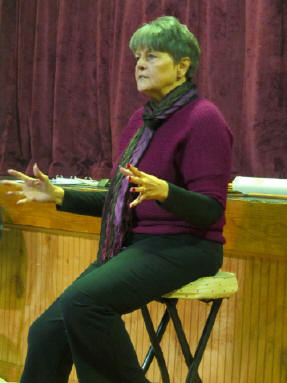Two-hour How-to Storytelling Marathon
By
Marilyn Kinsella, Taleypo the Storyteller
Introduction: Northland Storytelling Network
Goals:
- To learn “The Process”
- To “Tell a Story”
- To “Tell at a Concert”
- To “Make Storytelling a Part of Your Life”
Types of Stories – Literary, Original, Historical, Personal Experience, Myths
Folktales – Fairy Tales, Fables, How and Why, Trickster, Ghost, Tall Tales, Urban Legends, Legends, Noodlehead, Sacred (see Folktales from Simple to Complex)
Why Folktales?? Discuss.
The Process Demonstrated
- Find a Story – Listen to live storytellers at guild meetings, special events, festivals… or listen to storytelling tapes… or watch DVDs of storytellers. Read folktales - 398.2 adult folktale section of the library. J 398.2 juvenile section and E 398.2 picture book section. Internet – type in the name of the story and follow various searches. Finding “Chit Chat” Shari Lewis’ One-Minute Folk Tales
- Tell the basics “Chit Chat”
- Demonstrate the following:
- Visualize the story with the group
- Tell about the story to self
- Make a mnemonic
· Folded piece of paper into 8 sections
· Story Map
· Outline
· Movement
- Practice Telling – in the car, with your kids, with your class, with your guild
- Tell “Chit Chat” – or a portion of it.
The Process Workshop
-
Hand out stories
- Read your story silently
- Visualize it
- Tell the story to yourself
- Make a mnemonic with folded piece of paper
Developing Your Own Story
- Using the paper tell the story to a partner
- Put paper down – visualize the scenes – add descriptions using the senses. Tell to a partner
- Visualize characters – add descriptions, attitude, way they carry themselves, how they walk, etc. Tell to a partner
- Listen to your characters’ voices – rough, sweet, conniving, jerky, etc. Add more dialog by actually saying what your characters said and the reactions of the other characters. Tell to a partner
- Look for places to add more images – esp. using the senses, emotions, asides to the audience, sound effects, audience participation. Tell to a partner
To Tell A Story:
Review positive affirmations and suggestions - Each participant tell to the whole group
Tell A Story at a Concert: Hopefully, we can tell stories to the day camps
To Make Storytelling a Part of Your Life
Why:
· Entertain Kids
· Teach a Lesson (bullying, character traits, religious)
· Learn Speech Techniques
· To Enhance a Lesson
· To Give Back
· To Be Creative
· To Open New Doors
· To Have That “Something Special”
· To Challenge Yourself to Try Something New”
· To Appreciate the Art of Storytelling
Where:
- At Your Job – teacher, camp counselor, business executive, librarian, youth minister, scout master, entertainer, and more
- For your family – bedtime stories, around the table, in the car, reunions
- At Guild Meetings - Riverwind Storytellers (meetings every second Wednesday, Tellabration, Special Events) Northland Storytelling Network, National Storytelling Network. All of these have websites.
